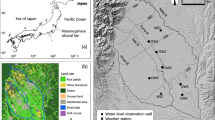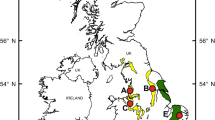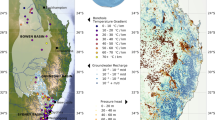Abstract
To determine the relative impact of climate and human intervention on groundwater elevations in western Victoria, southeast Australia, bore hydrograph fluctuations in three aquifers were modelled using a transfer function noise model (PIRFICT) and an auto-regressive model (HARTT), which give generally comparable results. Most of the groundwater-level fluctuations (>90%) are explained by climatic variation, particularly rainfall. The overall non-climate-related trend in groundwater level is downward and small but statistically significant (−0.04 to −0.066 m/yr), and is probably due to the widespread replacement of grazing land by wheat and canola cultivation, as these crops use more water than pasture. A large non-climate-related trend (−0.30 m/yr) for bores in an irrigation area is mainly related to groundwater extraction. The response time of the system is rapid (only 4.85 years on average), much faster than previously estimated. Rates of groundwater flow are much slower; groundwater ages are up to ~35,000 years. Response times effectively represent the time for the system to move to a new state of hydrologic equilibrium; this prediction of the time scale of the impacts of land-use change on groundwater resources will allow the development of better strategies for groundwater management.
Résumé
Pour déterminer l’impact relatif du climat et de l’intervention humaine sur le niveau de la nappe, Ouest Victoria, Australie du Sud, on a modélisé les fluctuations de niveau de trois aquifères en utilisant une fonction de transfert de bruit (PIRFICT) et un modèle de régression (HARTT), qui donnent généralement des résultats comparables. La plupart des variations du niveau de nappe (>90%) sont expliquées par les variations climatiques, particulièrement par les précipitations. La composante de la baisse non liée au climat, petite mais statistiquement significative (–0.04 to –0.066 m/an), est probablement due au large remplacement des pâturages par la culture de l’avoine et du canola, ces cultures utilisant plus d’eau que le pâturage. Une composante importante de la tendance indépendante climat (–0.30 m/an) est principalement en relation avec le pompage sur aire irriguée. Le temps de réponse du système est court (seulement 4.85 ans en moyenne), beaucoup plus rapide que précédemment estimé. Les taux d’écoulement souterrains sont beaucoup plus faibles, les âges de la nappe atteignant ~35,000 an. Les temps de réponse représentent la durée effectivement nécessaire pour l’évolution du système vers un nouvel état d’équilibre hydrologique; cette prévision dans le temps des impacts sur la ressource souterraine du changement d’utilisation du sol permettra le développement de meilleures stratégies de gestion de la nappe.
Resumen
Para determinar el impacto relativo del clima y la intervención humana sobre las elevaciones de agua subterránea en Victoria Oeste, sudeste de Australia, se modelaron las fluctuaciones de los hidrogramas de pozos en tres acuíferos usando un modelo de función de la transferencia de ruido (PIRFICT) y un modelo auto – regresivo (HARTT), los cuales generalmente dieron resultados comparables. La mayor parte de las fluctuaciones de los niveles de agua subterráneas (>90%) se explican por variaciones climáticas, particularmente de la precipitación. La tendencia general no relacionada con el clima en los niveles de agua subterránea es descendente y pequeña pero estadísticamente significativa (–0.04 a –0.066 m/año), y es probablemente debido al reemplazo generalizado de las tierras de pastoreo por cultivos de trigo y canola, debido a que estos cultivos utilizan más agua que las pasturas. Una tendencia grande no climática (–0.30 m/año) para los pozos en un área de irrigación está relacionada principalmente a la extracción de agua subterránea. El tiempo de respuesta del sistema es rápido (sólo 4.85 años en promedio), mucho más rápido que los estimados previamente. Los ritmos del flujo de agua subterránea son muchos menores, las edades del agua subterránea son hasta ~35,000 años. Los tiempos de respuesta representan efectivamente el tiempo en que el sistema se mueve a un nuevo estado de equilibrio hidrológico: esta predicción de la escala de tiempo de los impactos del cambio de uso de la tierra sobre los recursos de agua subterránea permitirá el desarrollo de mejores estrategias para la gestión de las aguas subterráneas.
摘要
为了确定澳大利亚东南部维多利亚西部地区气候和人类干预对地下水位的影响,本研究利用传递函数噪声模型(PIRFICT)和自回归模型(HARTT)对三个含水层的钻孔水位波动进行模拟 ,两者结果可比。结果表明大多数(超过90 %)地下水水位波动都是气候变化导致的,特别是降雨。非气候相关因子对地下水水位的综合影响较小且呈下降趋势,但相关性明显(–0.04 到 –0.066 m/yr)。造成这一现状的可能原因是该区普遍存在着需水量更大的小麦和油菜种植代替了原来的牧草地。灌溉区非气候相关因素对地下水水位的影响(–0.30 m/yr)与地下水开采相关。该系统的响应时间快(平均只有4.85年),比之前估计的快得多。而地下水流速相对这一响应速度要慢得多,地下水年龄高达35000年。系统响应时间可以有效表征系统达到新水文平衡状态所需时间。预测土地利用变化对地下水资源影响的时间尺度可以更好的制定地下水管理战略。
Resumo
Para determinar os impactes relativos do clima e da intervenção humana nos níveis de água subterrânea em Vitória ocidental, sudeste da Austrália, foram modeladas as flutuações registadas em hidrógrafos de furos em três aquíferos, recorrendo ao uso de um modelo de função de transferência de ruído (PIRFICT) e um modelo autoregressivo (HARTT), os quais dão resultados geralmente comparáveis. A maioria das flutuações de nível das águas subterrâneas (>90%) são explicadas pela variação climática, particularmente a precipitação. A tendência global não relacionada com o clima é negativa e pequena, embora estatisticamente significativa (–0.04 a –0.066 m/ano), e é provavelmente devida à extensa substituição de terras de pastagem pelas culturas de trigo e colza, uma vez que estas culturas usam mais água que as pastagens. Uma grande tendência não relacionada com o clima (–0.30 m/ano) para os furos em áreas regadas está fundamentalmente relacionada com extracção de águas subterrâneas. O tempo de resposta do sistema é rápido (apenas 4.85 anos em média), muito mais rápido do que as estimativas anteriores. As taxas de fluxo das águas subterrâneas são muito mais lentas; as idades das águas subterrâneas vão até aos ~35,000 anos. Os tempos de resposta representam efectivamente o tempo que o sistema demora a mover-se para um novo estado de equilíbrio hidrológico; esta predição da escala do tempo dos impactes das alterações do uso do solo nos recursos hídricos subterrâneos permitirá o desenvolvimento de melhores estratégias para a gestão das águas subterrâneas.




Similar content being viewed by others
References
Abramowitz M, Stegun IA (1964) Handbook of mathematical functions. Dover, New York
Allen RG, Pereira LS, Raes D, Smith M (1998) Crop evapotranspiration: guidelines for computing crop water requirements. FAO Irrigation and drainage paper 56, FAO, Rome
Allison GB, Cook PG, Barnett SR, Walker GR, Jolly ID, Hughes MW (1990) Land clearance and river salinisation in the western Murray Basin, Australia. J Hydrol 119:1–20
ANRA (2009) Water resources: allocation and use, Victoria. Australian Natural Resources Atlas. Available online http://www.anra.gov.au/topics/water/allocation/vic/. Cited 11 December 2009
Bennetts DA (2005) Hydrology, hydrogeology and hydrogeochemistry of groundwater flow systems within the Hamilton Basalt Plains, and their role in dryland salinity. PhD Thesis, La Trobe University, Australia
Bennetts DA, Webb JA, Gray CM (2003) Distribution of Plio-Pleistocene basalts and regolith around Hamilton, western Victoria, and their relationship to groundwater recharge and discharge. Proceedings from Advances in Regolith. CRC LEME, Perth, Australia, pp 11–15
Bennetts DA, Webb JA, Stone DJM, Hill DM (2006) Understanding the salinisation process for groundwater in an area of southeastern Australia, using hydrochemical and isotopic evidence. J Hydrol 323:178–192
Bennetts DA, Webb JA, McCaskill M, Zollinger R (2007) Dryland salinity processes within the discharge zone of a local groundwater system, southeastern Australia. Hydrogeol J 15:1197–1210
Bolger TP, Turner NC (1999) Water use efficiency and water use of Mediterranean annual pastures in southern Australia. Aust J Agr Res 50:1035–1046
Box GEP, Jenkins GM (1976) Time series analysis: forecasting and control. Holden-Day, San Francisco
Callow JN, Smettem KRJ (2009) The effect of farm dams and constructed banks on hydrologic connectivity and runoff estimation in agricultural landscapes. Environ Modell Softw 24(8):959–968
Coram JE, Dyson PR, Houlder PA, Evans WR (2000) Australian groundwater flow systems contributing to dry land salinity. Report by Bureau of Rural Sciences for the Dry land Salinity Theme of the National Land and Water Resources Audit, Canberra, Australia
Dahlhaus PG, Heislers DS, Dyson PR (2002) Groundwater flow systems. Consulting report Glenelg-Hopkins Catchment Management Authority 02/02, Hamilton, Victoria, Australia
Dahlhaus PG, Cox JW, Simmons CT, Smitt CM (2008) Beyond hydrogeologic evidence: challenging the current assumptions about salinity processes in the Corangamite region, Australia. Hydrogeol J 16:1283–1298
De Gruijter JJ, Brus DJ, Bierkens MFP, Knotters M (2006) Sampling for natural resources monitoring. Springer, Berlin
DERM (2010) Climate data. Department of Environmental and Resources Management, Queensland. Available online http://derm.qld.au/services_resources. Cited 25 May 2010
Favreau G, Cappelaere B, Massuel S, Leblanc M, Boucher M, Boulain N, Leduc C (2009) Land clearing, climate variability, and water resources increase in semiarid southwest Niger: a review. Water Resour Res 45:W00A16
Ferdowsian R, Pannell D, McCarron C, Ryder A, Crossing L (2001) Explaining groundwater hydrographs: separating atypical rainfall events from time trends. Aust J Soil Res 39:861–875
French RJ, Schultz JE (1984) Water use efficiency of wheat in a Mediterranean-type environment. I. The relationship between yield, water use and climate. Aust J Agr Res 35:743–764
Garden D (1984) Hamilton: a western district history. Hargreem, Melbourne, Australia
Grimes KG (1998) The Scott Creek karst: stream drainage diverted underground by a lava flow? In: Shannon R (ed) Karst studies seminar abstracts. Australian Speleological Federation, Mole Creek, Tasmania, pp 14–15
Hipel KW, McLeod AI (1994) Time series modeling of water resources and environmental systems. Elsevier, Amsterdam
Ierodiaconou D, Laurenson L, Leblanc M, Stagnitti F, Duff G, Salzman S, Versace V (2005) Consequences of land use change on nutrient exports: a regional scale assessment in south-west Victoria, Australia. J Environ Manage 74(4):305–316
Jenkin JJ, Dyson PR (1983) Groundwater and soil salinisation near Bendigo, Victoria. In: Knight MJ, Minty EJ, Smith RB (eds) Collected case studies in engineering geology, hydrogeology and environmental geology. Geological Society of Australia, Sydney, Australia
Jury WA, Roth K (1990) Transfer functions and solute movement through soil: theory and applications. Birkhauser, Basel, Switzerland
Knotters M, Bierkens MFP (2000) Physical basis of time series models for water table depths. Water Resour Res 36:181–188
Leblanc MJ, Favreau G, Massuel S, Tweed S, Loireau M, Cappelaere B (2008) Land clearance and hydrological change in the Sahel: SW Niger. Glob Planet Change 61:135–150
Leblanc MJ, Tregoning P, Ramillien G, Tweed S, Fakes A (2009) Basin scale, integrated observations of the 21st century multi-year drought in southeast Australia. Water Resour Res 45:W04408. doi:10.1029/2008WR007333
Maas C (1994) On convolution processes and dispersive groundwater flow. PhD Thesis, Delft University of Technology, The Netherlands
Neal BP, Nathan RJ, Schreider SY, Jakeman AJ (2002) Identifying the separate impact of farm dams and land use changes on catchment yield. Aust J Water Resour 5(2):165–175
NLWRA (2001) Australian dryland salinity assessment 2000. National Land and Water Resources Audit), Canberra, ACT, Australia
Peck AJ, Williamson DR (1987) Effects of forest clearing on groundwater. J Hydrol 94:47–65
Raiber M (2008) Hydrogeological and hydrogeochemical studies of aquifer and groundwater–surface water interactions and their impact on water resources in the basalt plains of western Victoria, Australia. PhD Thesis, La Trobe University, Australia
Raiber M, Webb JA (2008) Development of the streatham deep lead system in western Victoria: implications for Tertiary tectonism and landscape evolution. Aust J Earth Sci 55: 493–508
Raiber M, Webb JA, Bennetts DA (2009) Strontium isotopes as tracers to delineate aquifer interactions and the influence of rainfall in the basalt plains of southeastern Australia. J Hydrol 367:188–199
Rancic A, Salas G, Kathuria A, Acworth I, Johnston W, Smithson A, Beale G (2009) Climatic influence on shallow fractured-rock groundwater system in the Murray-Darling Basin. Department of Environment and Climate Change NSW, Sydney
Robertson MJ, Kirkegaard JA (2005) Water-use efficiency of dryland canola in an equi-seasonal rainfall environment. Aust J Agr Res 56:1373–1386
Rock NMS, Webb JA, McNaughton NJ, Bell GD (1987) Nonparametric estimation of averages and errors for small data-sets in isotope geoscience: a proposal. Chem Geol 66:163–177
Scanlon BR, Reedy RC, Stonestrom DA, Prudic DE, Dennehy KF (2005) Impact of land use and land cover change on groundwater recharge and quality in the southwestern US. Glob Chang Biol 11:1577–1593
Scanlon BR, Jolly I, Sophocleous M, Zhang L (2007) Global impacts of conversions from natural to agricultural ecosystems on water resources: quantity versus quality. Water Resour Res 43:W03437. doi:10.1029/2006WR005486
Schreider SY, Jakeman AJ, Letcher RA, Nathan RJ, Neal BP, Beavis SG (2002) Detecting changes in stream flow response to changes in non-climatic catchment conditions: farm dam development in the Murray-Darling basin, Australia. J Hydrol 262:84–98
Stanley DR (1992) Groundwater usage and resource potential along the northern margin of the basalt plains, western Victoria. Rural Water Commission Report, 1992/6, RWC, Melbourne, Australia
Tankersley CD, Graham WD (1994) Development of an optimal control system for maintaining minimum groundwater levels. Water Resour Res 30:3171–3181
Van Geer FC, Zuur AF (1997) An extension of Box-Jenkins transfer/noise models for spatial interpolation of groundwater head series. J Hydrol 192:65–80
Von Asmuth JR, Knotters M (2004) Characterising groundwater dynamics based on a system identification approach. J Hydrol 296:118–134
Von Asmuth JR, Maas C (2001) The method of impulse response moments: a new method integrating time series, groundwater and eco-hydrological modeling. In: Geherls JC, Peters NE, Hoehn E, Jensen K, Leibundgut C, Griffioen J, Webb B, Zaadnoordijk WJ (eds) Impact of human activity on groundwater dynamics. IAHS Publ., IAHS, Wallingford, UK, pp 51–58
Von Asmuth JR, Bierkens MFP, Maas C (2002) Transfer function noise modeling in continuous time using predefined impulse response functions. Water Resour Res 38(12):23.1–23.12
Von Asmuth JR, Maas C, Knotters M, Leunk I (2010) Menyanthes manual, version 1.9.3. KWR, Water cycle Research Institute, Nieuwegein, The Netherlands
Ziemer RE, Tranter WH, Fannin DR (1998) Signals and systems: continuous and discrete, 4th edn. Prentice-Hall, Upper Saddle River, NJ
Acknowledgements
This work was conducted in collaboration with and funded by the Glenelg-Hopkins Catchment Management Authority, Victoria, Australia. The authors also wish to acknowledge C. Maas, J. R. Von Asmuth and J. Luit (from KWR, The Netherlands), R. Ferdowsian (HARTT developer, Department of Agriculture, Western Australia), S. White (La Trobe University) and two anonymous reviewers for their useful comments which substantially improved this report.
Author information
Authors and Affiliations
Corresponding author
Rights and permissions
About this article
Cite this article
Yihdego, Y., Webb, J.A. Modeling of bore hydrographs to determine the impact of climate and land-use change in a temperate subhumid region of southeastern Australia. Hydrogeol J 19, 877–887 (2011). https://doi.org/10.1007/s10040-011-0726-1
Received:
Accepted:
Published:
Issue Date:
DOI: https://doi.org/10.1007/s10040-011-0726-1




